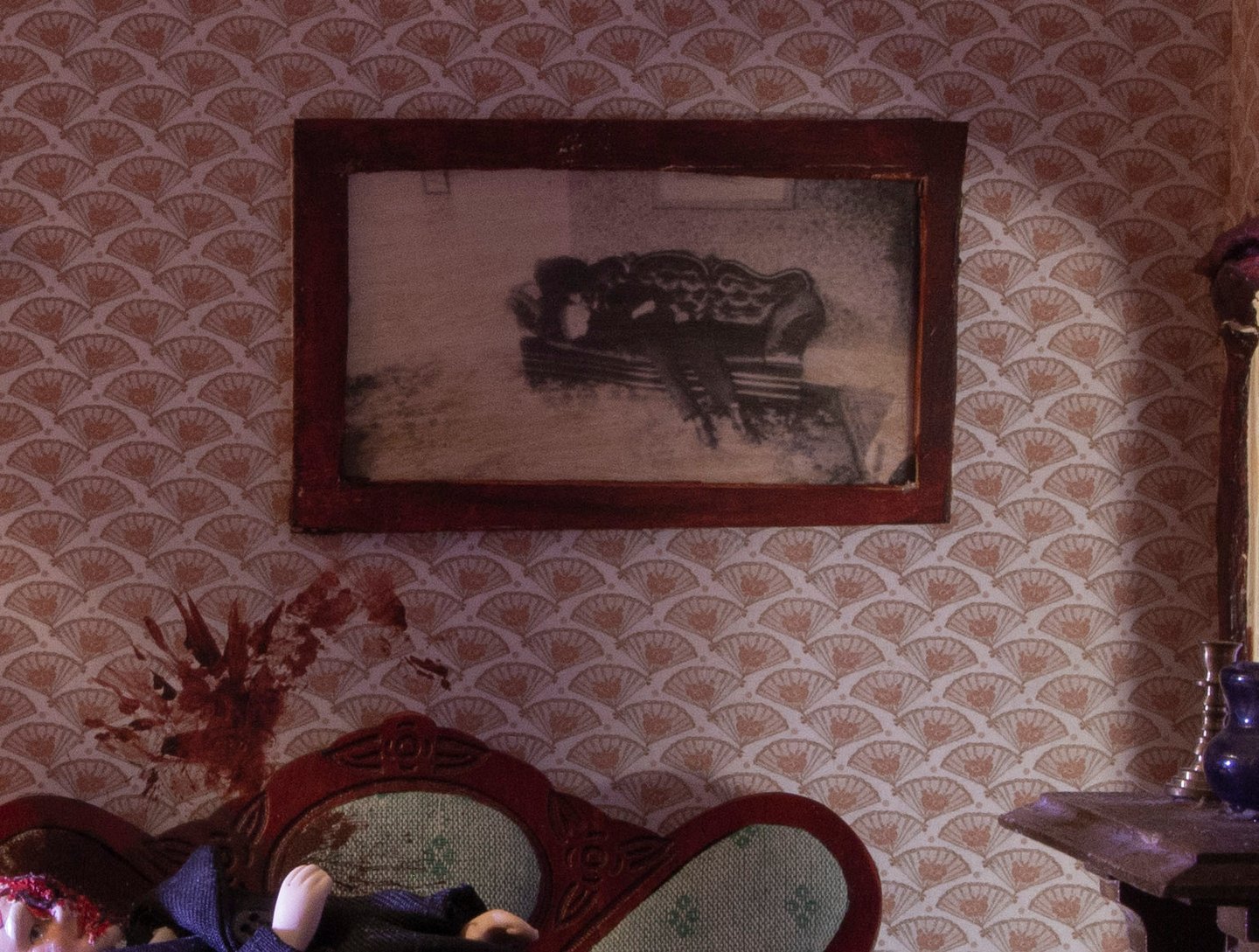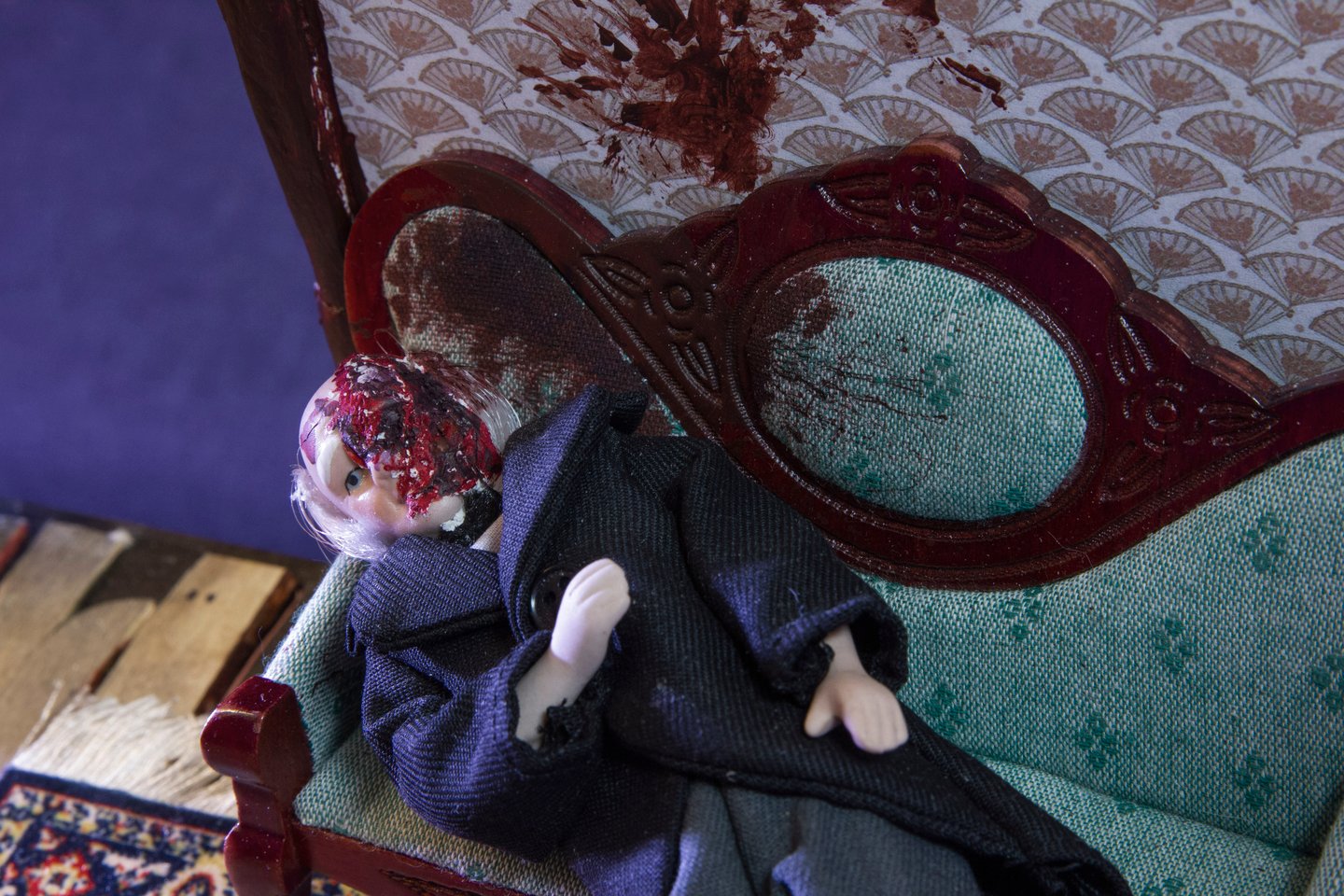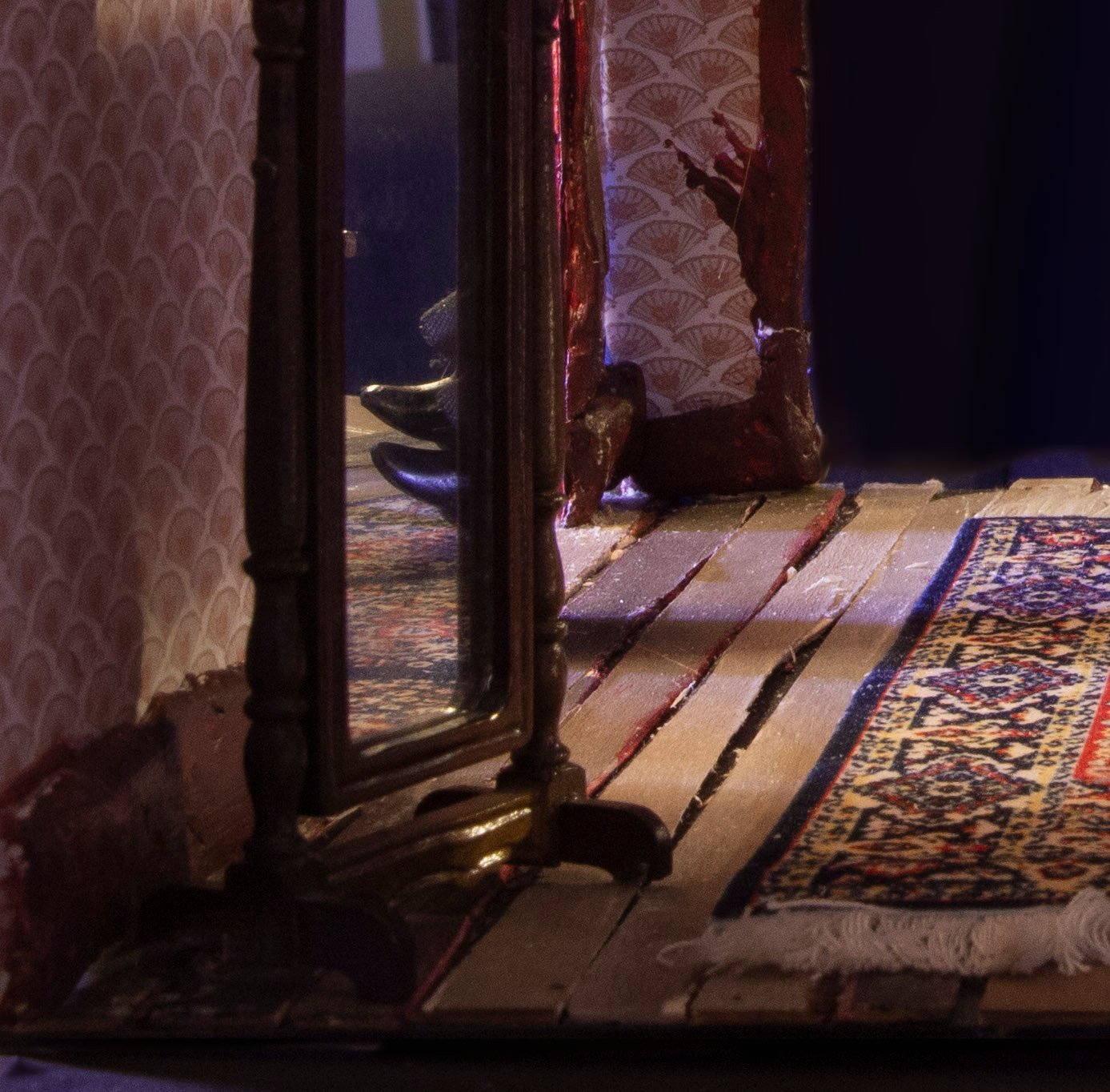My book haunted me, as did Lizzie Borden. I thought by making something with my hands, I could transform that fear into care.
When I was working on my book, in the long middle of it—after my father had died, but before I locked the manuscript in my desk drawer for months—I had a dream that stuck with me with violent viscerality. In the dream, my life was similar in some ways to my real life. I was working on a collection of poetry about the lesbian and acquitted family-murderer Lizzie Borden, and my bookshelves overflowed with reams of research. In the dream, and in real life, I wrote to distract myself from my nascent grief. I thought if I wrote hard and far enough into my subject, I would spare myself the emotional collateral of my father’s sudden passing. Needless to say, I was young, freshly twenty-three; I was foolish.
In the dream, I decided to go upstate to give myself more time to finish the book. I paid for an Airbnb for six months and brought all my research materials with me, settling in the pine-dappled cabin I rented. It was so pretty; a mulchy long field of a yard, a burbling crick. Before I knew it, the six months were up. I locked my manuscript in my drawer and called my friends. “I’ve finished my work,” I said. “I need to tidy up, and then you can come celebrate with me.”
I hung up the phone and began to clean, but as I swept I noticed the bristles of the broom were dappled with crimson, leaving tiny red streaks on the floor. I went out to walk on the mulch and my shoes squished out red. I washed a stack of dishes and saw a growing dark stain on the ceiling above the sink. I ran upstairs to the bedroom, and there I found blankets bundled around something wet and large, the mattress underneath soaking like a sponge. Then, finally, I realized my home was filled to the brim with bloodied, rotten bodies.
I ran around trying to hide the gore-drenched corpses, but every time I put one away—chopped into bits in the trash can, crumpled in the pantry next to a Cuisinart—I found more. Finally, I went back to my writing room. When I opened the locked drawer I had put the manuscript in, I saw jumbles of hands stacked to the top of the drawer, lopped off ragged and quick at the wrist. During those six months of dream time, I had not written a word but instead had killed and killed again.
I woke up and stopped writing the book for as long as I could, until it welled out of me again. The dream was actually why I locked the manuscript up in reality: I closed my desk drawer and reckoned this pause in my process signaled a type of healing. I thought, through the dream, that I had done the hardest work already. I didn’t touch it, oddly enough, for almost six months.
*
I had started writing Blood Box , this book full of queer intimacy and bile and fear, in 2017 . I was writing about Lizzie Borden, a woman who murdered her stepmother and father at the turn of the twentieth century in the middle of the day and got acquitted. I wrote the book as my father was dying. The writing filled time that otherwise stretched on endlessly, but also—in focusing on a father undoubtedly cruel to Lizzie Borden, but who Lizzie seemed to love even despite this cruelty—I thought I had found a way to heal from the violence and love twined indistinguishably close together that my father bequeathed me.
I work, in many ways, in miniature. When writing, I make spreadsheet tables and draw diagrams to fit poems within. I adjust my Google Docs margins as small as I can and size down the font to nine- or eight-point and zoom in. I try to look as closely at something as I can until I can’t look any longer and call that process revision. I excavate—which is a word that literally means to hollow out, to make smaller. I cut and cut away until there are just slivers left. This is how I wrote the book: through slivering away over a whole unbearable spring and summer.
Because of this predilection for working small, I wasn’t surprised when I started dreaming of miniatures around the two-year anniversary of the book. Plans had actually been swirling around in my head for a year before that, but I had just been released from the hospital and was recovering from appendicitis and needed something to occupy my time. So to commemorate what I wrote, I decided to make a crime scene.
photograph courtesy of the author
At that point, I was both fascinated and disgusted with Frances Glessner Lee, the woman who bankrolled much of the Chicago Police Department in the early 1900s. Lee hosted elaborate galas where the police would be asked to solve elaborate dollhouse murders that she built: tiny mothers oven-asphyxiated in their ranch homes, or doll men hanging from floss-thin braided nooses in the barn. I hated her dedication — one shared by many white women — to the idea of police as a solution to violent crime, as opposed to another manifestation of it. But in the dolls, which she crafted all by hand in excruciating detail, I saw a kind of care directed at something that so obviously terrified her. My book haunted me, as did Lizzie Borden. I thought by making something with my hands, I could transform that fear into care too.
Before my dream, Lizzie’s life was easy to write about because the excavation the project required had nothing to do with me. For most of 2017, I had plunged myself into research: corresponding with clerks to get scans of her inquest, lurking on forums, checking dozens of books out of the Brooklyn Public Library and scouring their works-cited pages to find primary documents I might have overlooked. My notebooks spilled over with facts about her and the long narrow coffin-box of a house she lived in—a place with no hallways, the rooms tumbling open into each other, six people living in its two stories (Lizzie, her father, her stepmother, her sister, the maid, the uncle from out of town) at the time of the murder. I looked at photo after photo of Lizzie’s rounded, soft-butch face and dreamed about what her nights were like.
I wrote the book in the attic of the queer co-op I lived in, where my bedroom was; despite the twenty-two people I shared a house with, the place got bone quiet at night. When I was finished writing for the day, I would creak my way across the floorboards to the bathroom, the ceiling so low I had to duck in spots. In that attic, I wrote about Lizzie as a way to hide from writing about myself, but the dream reminded me you can’t hide yourself, however much you want to. The you keeps burbling underneath nonetheless.
*
Like the book, making the miniature seemed easy, immersive at first—a welcome distraction from myself. I began researching yet again: first the grimy crime-scene photographs of her father, head meloned open on the fainting couch; then swatches of period-appropriate wallpaper and blood-splatter analysis to simulate what being struck with a hatchet might look like on a ceramic doll. I bought metal rulers and thin sheets of plywood, fresh X-Acto knives and modeling clay and dollhouse glue. I bid on eBay for the cheapest dollhouse accessories I could find, then cut them down and repainted them and built them back up for the house. I replaced a blurry portrait of some flowers with Andrew Borden’s own crime scene photo, resting like a crown above his own hacked-in head. I estimated I could be done in a week or two, though it actually took me almost two months to construct the whole room. I knew I was building a ritual, a monument of sorts, but I didn’t know yet what for.
The more I worked on the miniature, the more it lingered. It had been just over four years since my father died, and I was as oblivious then as I was when I dreamed about my violent writing retreat. I started carrying the model out of my bedroom at night; during the day, I posed Andrew’s gored face away from me. As I looked over what I was making—like I did while writing the book—I felt a quiet panic. I ignored my feelings of disquiet; I didn’t even think about grief. I figured the emotions flowing from me, in their own way, were another type of excavation. As I glued the walls of the model together, looking at Andrew’s hatcheted face—a clay application I modeled to one-tenth scale, painted and scored in shades of red and deep purple with brushes the size of an eyelash—I found my eyes watering, and I started to cry.
photograph courtesy of the author
The writing I relate to, I’ve often thought, is like a knife. It can be used to cut your enemies, it can be used to cut into a greater precision of thought and feeling, and if you have nothing else at your disposal it can be used to cut yourself as well.
When I built the dollhouse, I used X-Acto knives and a box cutter, and the blades of all of them wore down while cutting plywood into quarter-inch strips for the boards. I cut whole sheets of plyboard into the frame of the house, slicing out and wallpapering the doorframes one by one. There was a rhythm to the work, one that—because of its repetitiveness—I thought was redemptive as well, purging all the feelings I felt around my father’s death. In the whittling, sawing, sanding, and staining that I needed to make each warped floorboard—that I needed to make the whole dollhouse—I got lost, and because I was lost I assumed the quiet parts of me were healing how they needed to.
photograph courtesy of the author
*
My father died in a hospital after a several-month decline following open-heart surgery. The year he was hospitalized, he wrote me an email I found unimaginably cruel. I had opened it on my phone in the corner of a dance floor on New Year’s Day at 3 a.m. In it, he said: You are not my daughter. He said: Because you grew up with a sister who had died before you, because we did not hide it from you, that is why you’re fucking up your body. He said: Your mother’s inability to conceal her grief is why your gender and sexuality is wrong.
At that moment, boyfriend dancing in the center of the room, I decided not to talk to my father ever again. And for five months, I didn’t. In fact, it was only an impulse, nagging and unarticulable at the time, that led to me responding to his fourth apology, meeting for coffee, and setting the terms of our relationship one week before he admitted himself into the hospital he would die in.
Blood Box was not an act of forgiving my father, although I dedicated the book to him. I’m not sure I believe that forgiveness lives in words like that. I think language’s legacy is far rockier and uncertain. Instead, I wrote my book as a hidden autobiography, a way to think about how queerness and family violence—verbal and sexual in Lizzie’s case, verbal and physical in my own—are often inextricable. I wrote it content in the knowledge that if anyone tried to read me into the work, they’d have to do the labor of reading past the innumerable differences between Lizzie’s life and my own: our geographies, our class status, our genders. But I dedicated the book to my father—including his birth and death dates on the first page like a tombstone—because I hoped some readers would try anyway. And I started the dollhouse, without even consciously realizing it, right after his birthday. The book was intertwined with him, so of course the model was too.
So when I wept making the dollhouse, I decided I needed to take space from it. Moved into another room, the model breathed on its own as I paid attention to the rhythms of my own life, everything I had been ignoring. I wrote down my thoughts, drank kava, saw lovers. I cried when I could. Despite my impulses, for the next several weeks I tried to stop working in miniature, living as largely as I could as an immunocompromised person in a pandemic. I wrote, laughed, had less frightening dreams. I didn’t let my story be told explicitly through grief, but I held space for the complexity of the grief anyway. Maybe that’s what draws people to writing: the opportunity to rehearse the rhythms of a life, holding and disguising the fear and the expanse of what we’ve lived until we can turn around and live it again.
My father was cruel—a lifelong alcoholic, he had a knack for piercing intimacy with a meanness almost mechanical, quotidian in its affect—but the hardest thing about dealing with his cruelty was all the times he wasn’t. A week before he sent the email, on Christmas, he gave me a pair of earrings and said, “I’m so proud of who you’ve become.” Four months before he sent the email, he took me out for burritos, saying, “I wish you’d let me into your life more.”
I didn’t imagine murdering my father, like I believe Lizzie had, but for years I dreamed him dead. And then the summer I was writing the book I found it actually happening, and I became racked with guilt. My father’s slow death was terrible, not at all what I was dreaming—but I had been dreaming it nonetheless. Writing isn’t healing, but I understand why I thought it could be. Who could see that synchronicity and not think the only way out was through?
Cutting anything down can be a way to stay alive, but it can also distract from the other work of living as well. You can’t ritual your way out of grief or out of feeling things; trying to do so, in fact, sometimes makes things worse. This was the warning around writing through my feelings that my dream tried to tell me; this was the same mistake I made while starting the dollhouse too.
But in the endless rehearsals, I eventually felt less haunted. When I needed to stop, I took a break. That’s something writing can do as well: In breaking my book open, I avoided fully breaking myself. I stopped, and then I kept going. I have to take that as a sign of growth.
*
Several weeks after setting the dollhouse aside, I sat down at my wobbly writing desk, picked up the box cutter, and continued slicing and sanding away. I cut and cut until finally it was finished.
The dollhouse is in my spare room now; I pass it every morning when I go to get my coffee. Light streams in through the doors of the model, the floorboards mottled and slightly dusty. Meanwhile, the corners of my bedroom curtains are flecked with bits of crimson paint and my desk is stained red too—but dried, not wet, not dripping. There’s nothing in the drawers. I go for walks outside, do my little rituals to help myself, and write—not obsessively, but when I can. In the other room, the doll father’s porcelain clay face glistens, dappled with light, christened bright as a setting sun.



